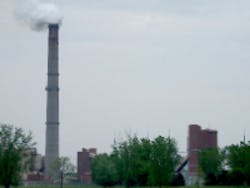WaterWorld Weekly Newscast, December 12, 2016
The following is a transcript of the WaterWorld Weekly Newscast for December 12, 2016.
Hi, I'm Angela Godwin for WaterWorld magazine, bringing you water and wastewater news headlines for the week of December 12. Coming up...
House passes water infrastructure compromise bill
UM-Flint mobile app helps manage ongoing water crisis
Water associations challenge EPA steam power plant rule
Bureau of Reclamation releases water markets report
Last week, the House of Representatives passed a comprehensive water bill that rolls together the Water Resources Development Act of 2016, the Water and Waste Act of 2016, and significant tribal and natural resources legislation, among other measures.
The nearly $12 billion Water Infrastructure Improvements for the Nation Act includes $170 million in authorizations for aid to Flint, Mich., as well as 30 new Corps infrastructure projects across the country.
Another highlight: it would provide $20 million for the Water Infrastructure Finance and Innovation Act -- or WIFIA -- in 2017, which AWWA said will pave the way for up to $1.2 billion in loans to support critical water infrastructure projects.
The measure passed with a vote of 360-61, but not without controversy. In particular, some lawmakers opposed language pertaining to drought relief for central and southern California that would relax environmental standards and divert more water to farms.
The bill now heads to the Senate for consideration.
With funding from Google.org, computer science researchers at the University of Michigan's Flint and Ann Arbor campuses have developed a mobile app and website for the city of Flint to help the community and government agencies manage the ongoing water crisis.
Mywater-Flint, for Android and online at Mywater-flint.com, allows residents and city access to a wide array of useful information, such as a citywide map of where lead has been found in drinking water and where service line workers have replaced infrastructure that connects homes to the water main as well as where they're currently working.
Through the app, residents can also locate the nearest distribution centers for water and water filters, and find step-by-step instructions for water testing.
The app can even predict which homes are more likely to have lead issues based on factors such as the age of the property, its location, value and size.
The app's developers say, most importantly, it increases transparency.
Visit Mywater-Flint.com to learn more.
Last week, in a brief filed in the 5th Circuit Court of Appeals, the American Water Works Association and the National Association of Water Companies challenged EPA's final Effluent Limitation Guidelines for Steam Power Plants, arguing that it does not adequately protect drinking water consumers.
The water associations contend that the portion of the rule addressing bromide discharges should be sent back to EPA for further review because bromide discharges impact source water quality and result in elevated levels of harmful disinfection byproducts in finished drinking water.
The rule, they say, imposes compliance challenges and additional costs on downstream water treatment plants instead of on the upstream power plants responsible for the pollution.
The Bureau of Reclamation has released a new report that highlights how the agency has partnered with water users to enable water market transactions, such as voluntary trading of water rights.
Water users in the West have used many different approaches to address water needs particular to their location, and this report reviews a series of case studies that illustrate locally-led innovation that resulted in collaborations and programs to solve water challenges through market-based agreements.
To read the report, visit usbr.gov.
For WaterWorld magazine, I'm Angela Godwin. Thanks for watching.
